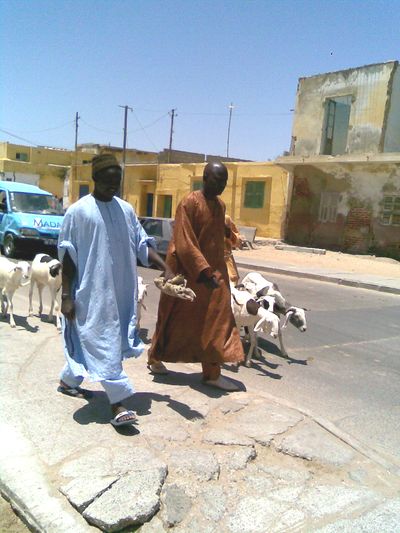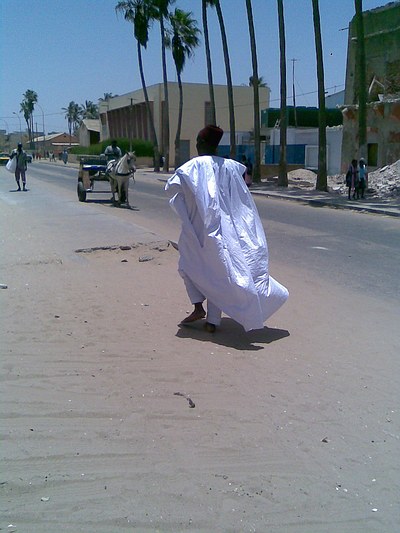| ||
Assorted ImpressionsMusic and Dancing
Check it out
Dancing is a big thing for the Senegalese. Their traditional dancing is of a very high energy with limbs wildly flying everywhere to a drummer’s rhythm. As well as being performed at family occasions or at nightclubs, groups of girls in particular would quite often break into impromptu jigs simply to express their satisfaction at something. I spent an afternoon in the company of a group of young men watching a DVD that was roughly the Senegalese equivalent of a Bollywood movie: a paper-thin plot designed to link dance scenes together. The story, which I think may actually be exactly the same for all films of this genre, was that a couple were trying to get some rest but were disturbed by the drums and dancing going on in the courtyard outside. Each time they came down to complain they would be involuntarily infected by the rhythm and join in with an extravagant performance of their own. The young men watching the film assured me they could all the same if called upon.
Social graces
Whenever entering a room in Senegal is considered polite to greet and shake the hands of those already there. A couple of times this friendly formality tripped me up. I was told off by Mr Fall for failing to greet a couple of teachers I’d never met when entering the staff-room. Similarly, when rushing to make an appointment I walked past two people I didn’t know sat at the entrance to the building without catching their eye. The person I was meeting made me go back to say hello to them.
On returning to London I had to resist the urge to shake hands with each of my colleagues on seeing them for the first time that day. To complete the contrast, I now work next to someone who doesn’t even bother to acknowledge my morning greeting.
Life as a Toubab
Being called "toubab" could occasionally get your goat
Your status as a “toubab” followed you about. As a foreigner walking down the street you were often the centre of attention, and the obvious target for anyone after a quick buck. Whenever I returned to my house the local toddlers would greet me with great enthusiasm. They would run up arms open-wide to me screaming “toubab” even if I’d never seen them before. This unfailingly affectionate welcoming party was of the things I most miss about my time there. At other times it could be irritating though, and volunteers who had been out for longer stints did seem to get worn down by it. The traders plying their generic African carvings could be rather tiresome. The standard sales technique was to get talking to you in the street, taking affront if you didn’t stop to chat. Then you’d be invited just to see what we in their shop. Here they would give you something for free, presumably to make you feel obliged to go back there. I resisted any sense of obligation and now have a largely unwanted collection animal carvings and leather necklaces on my coffee table. As skilled salesmen they would remember your name and approach you with it when they next saw you. Most impressive example of this was a Nigerian artist, a local character and well known to the other volunteers. I met him in the street and chatted to him for five minutes. Without giving me the hard sell he showed me his portfolio; rather than the sun burned African landscapes I was expecting it was a collection of increasingly lurid abstract collages. Three weeks later, having not seen him in-between, I bumped into him in a museum. Incredibly he still remembered my name, what I was doing in St Louis and what I did at home. Appealed by his lack of pushiness I would happily have purchased some of his artwork, had it not been so garishly awful.
Food and Drink
Senegalese are ofter decked out in beautiful flowing robes
As you might expect in a Muslim society, the Senegalese are not big drinkers and it would be quite unusual for them to drink at home. However there were quite a few bars in Saint Louis, frequented by locals as well as tourists. Cheapest of them all was the infamous “firemen’s bar”. Essentially a working man’s drinking den, it was a large dark room with a couple of plastic chairs, a hatch to serve beer and a television. It was comfortably the least atmospheric bar I’ve been to in my life, and perhaps the model for the Weatherspoons chain in England. Dinner at home would always be followed by tea, the making of which was quite a ritual in Senegal. Three rounds of progressively sweeter tea mixed with mint were drunk in a single preparation, all from vessels only slightly bigger than shot glasses. Here's a description lifted shamelessly and without attribution from somewhere on the web. Attaya (Senegalese Tea)
Attaya is the Senegalese tea ceremony. It’s served in three rounds. The first is strong and bitter, the second more sweet with a little mint, and the third is very sweet with more mint. It’s supposed to reflect friendship: The longer we’re together the sweeter it grows.
Round one (called Lewel)
Round two
Round three | ||
|
